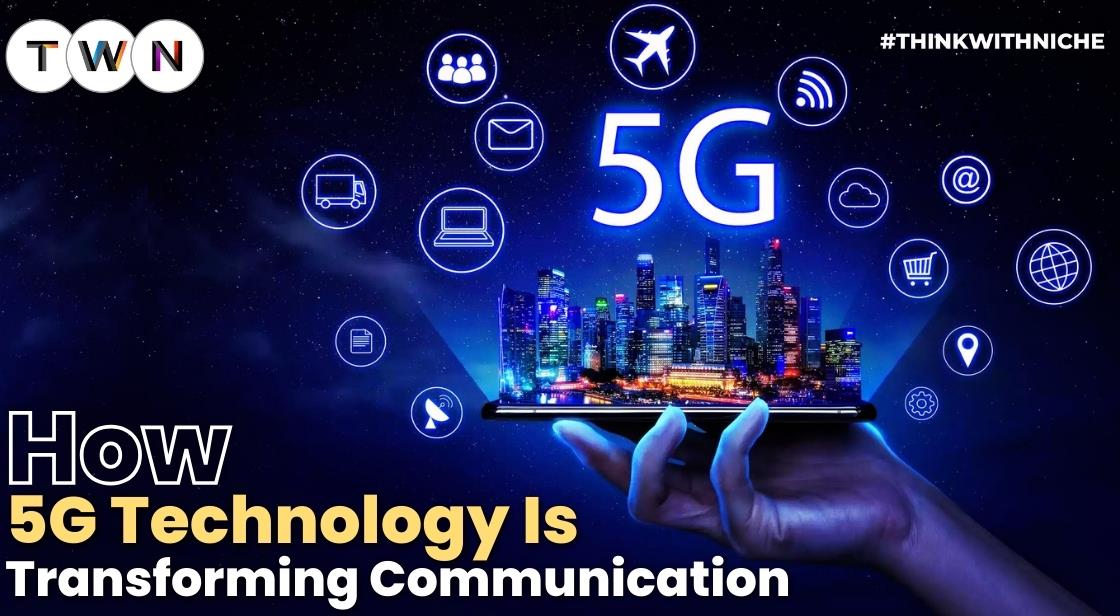How 5G Technology is Transforming Communication?

Blog Post
The advent of 5G technology marks a transformative leap in the evolution of wireless communication, promising to revolutionize the way we connect and interact in the digital age.
As the fifth generation of mobile networks, 5G is designed to significantly surpass the capabilities of its predecessors, offering unprecedented speeds, ultra-low latency, and enhanced connectivity.
This advanced technology not only addresses the increasing demand for faster and more reliable communication but also sets the stage for a new era of technological innovation.
5G's impact extends far beyond mere improvements in mobile internet speed; it is poised to drive substantial changes across various sectors. From revolutionizing the Internet of Things (IoT) and enabling smart cities to advancing healthcare and media entertainment, 5G technology is a catalyst for future developments.
However, as with any groundbreaking technology, its implementation brings challenges that need to be addressed, including infrastructure demands, security concerns, and regulatory hurdles.
In this blog, we will explore the profound impact of 5G on modern communication, examining its key features, potential future advancements, and the challenges that lie ahead.
By understanding the current capabilities and future prospects of 5G, we can better appreciate its role in shaping the future of connectivity and technology.
The Impact of 5G Technology on Modern Communication
Definition and Overview of 5G Technology
5G, or fifth-generation wireless technology, represents the latest advancement in mobile network technology, succeeding 4G LTE. It is designed to provide significantly faster data speeds, lower latency, and improved connectivity compared to its predecessors. 5G networks utilize a range of new technologies and spectrum bands to achieve these enhancements.
Key Features of 5G
One of the most notable features of 5G is its high-speed data transfer capabilities, which can exceed 10 Gbps, far surpassing the speeds of 4G networks. Additionally, 5G reduces latency to as low as 1 millisecond, enabling near-instantaneous communication. The technology also supports a massive increase in the number of connected devices, making it ideal for the growing Internet of Things (IoT) ecosystem.
Significance in Wireless Communication
The significance of 5G lies in its potential to revolutionize various aspects of communication and technology. It enables the development of smart cities, enhances remote working capabilities, and supports advanced applications such as autonomous vehicles and augmented reality. By improving network reliability and speed, 5G addresses the increasing demand for data and connectivity in a hyper-connected world.
Impact on Future Technology
5G technology is a crucial enabler for future innovations, providing the infrastructure needed for the next wave of technological advancements. Its implementation will drive progress across industries, from healthcare to entertainment, fundamentally changing how we interact with technology and each other.
Key Features of 5G Technology
5G technology represents the fifth generation of wireless communication, succeeding 4G with significant advancements in speed, latency, and connectivity. Its deployment marks a major leap forward in how data is transmitted and received, impacting various aspects of technology and daily life.
Higher Speeds
One of the most notable features of 5G is its significantly increased data transfer speeds compared to previous generations. While 4G networks typically offer speeds of up to 100 Mbps, 5G technology can deliver speeds ranging from 1 Gbps to 10 Gbps. This enhancement enables quicker downloads, smoother streaming, and more efficient handling of large data files, improving the overall user experience.
Lower Latency
5G technology dramatically reduces latency, the delay between sending and receiving data. While 4G networks have a latency of around 30-50 milliseconds, 5G can achieve latencies as low as 1 millisecond. This reduction is crucial for real-time applications such as online gaming, autonomous vehicles, and remote medical procedures, where even minor delays can have significant impacts.
Increased Connectivity
5G also improves connectivity by supporting a higher density of devices within a given area. It can connect up to 1 million devices per square kilometer, compared to 100,000 devices supported by 4G. This increased capacity is essential for the expansion of the Internet of Things (IoT), smart cities, and other applications requiring extensive network connections.
Enhancing Mobile Connectivity
5G technology represents a significant leap forward in mobile connectivity, offering a range of improvements over its predecessors. This advancement brings faster internet speeds and more reliable connections, transforming how users interact with digital services and applications.
Faster Internet Speeds
One of the most notable enhancements with 5G is the dramatic increase in internet speeds. 5G networks can deliver download speeds that are up to 100 times faster than those of 4G. This means that users can download large files, stream high-definition content, and access online services with unprecedented speed and efficiency.
Lower Latency
5G reduces latency, or the delay between sending and receiving data, to as low as 1 millisecond. This improvement ensures real-time communication and interaction, which is crucial for applications such as online gaming, virtual reality, and augmented reality. Lower latency enhances the overall user experience by making digital interactions more fluid and instantaneous.
Greater Network Capacity
5G networks are designed to handle a significantly higher number of devices simultaneously. This increased capacity means that more users can connect to the network without experiencing slowdowns or dropped connections, even in densely populated areas. The enhanced network infrastructure supports the growing number of connected devices and the expanding Internet of Things (IoT).
Improved Reliability
5G technology enhances network reliability by providing more stable connections. This improvement is particularly beneficial in urban environments and remote areas where network coverage can be inconsistent. With better signal strength and fewer interruptions, users experience more dependable connectivity for everyday tasks and critical communications.
Also Read: The Art of Building Emotional Connections in a Digital World
Revolutionizing Internet of Things (IoT)
Introduction to IoT and 5G
The Internet of Things (IoT) refers to the network of interconnected devices that communicate and share data with each other. 5G technology, with its high-speed connectivity and low latency, is poised to revolutionize IoT by significantly enhancing the capabilities and efficiency of connected devices.
Enhanced Device Connectivity
5G provides a substantial boost in connectivity, enabling more devices to be connected simultaneously without performance degradation. This improvement allows for a more extensive and dense network of smart devices, such as home automation systems, wearable health monitors, and industrial sensors.
Improved Data Transfer Speeds
With 5G’s increased bandwidth, IoT devices can transmit and receive data at much higher speeds compared to previous generations. This enhancement results in quicker updates, real-time data processing, and more responsive systems, which is crucial for applications like autonomous vehicles and real-time monitoring systems.
Lower Latency for Real-Time Applications
5G’s low latency significantly reduces the delay between data transmission and reception. This improvement is critical for applications requiring immediate feedback, such as remote surgery, industrial automation, and interactive augmented reality (AR) experiences.
Support for Advanced IoT Applications
The advanced capabilities of 5G enable the development of more sophisticated IoT applications. For instance, smart cities can leverage 5G to optimize traffic management, energy usage, and public safety systems. Similarly, smart factories can benefit from enhanced automation and predictive maintenance.
Transforming Communication in Business
Introduction to 5G in Business Communication
The advent of 5G technology is revolutionizing business communications by delivering unprecedented speed, connectivity, and efficiency. This transformation is reshaping how businesses operate, communicate, and collaborate.
Enhanced Remote Work Solutions
5G's high-speed internet and low latency are significantly improving remote work experiences. Employees can now engage in seamless video conferencing, real-time collaboration, and instant access to cloud-based applications without interruptions. This efficiency reduces downtime and enhances productivity, making remote work more viable and effective.
Improved Collaboration Tools
The enhanced bandwidth of 5G supports advanced collaboration tools, enabling real-time data sharing, high-quality video conferencing, and instant messaging. This leads to more dynamic and interactive meetings, where teams can work together on projects with greater ease, regardless of their geographical locations.
Streamlined Communication Processes
5G technology facilitates faster communication through various channels, including emails, messaging apps, and VoIP calls. This speed ensures that businesses can respond quickly to market changes, customer inquiries, and internal requests, thereby enhancing overall responsiveness and agility.
Advancements in Healthcare with 5G
Introduction to 5G in Healthcare
5G technology is set to revolutionize healthcare by enhancing connectivity and enabling advanced medical solutions. Its high-speed, low-latency capabilities are transforming telemedicine, remote surgeries, and healthcare data management.
Telemedicine Enhancements
5G significantly improves telemedicine by providing high-quality video consultations and real-time communication. This ensures that patients in remote areas have access to specialists, reducing the need for travel and facilitating timely medical interventions.
Remote Surgeries
With 5G, remote surgeries become more feasible due to its low latency and high-speed data transfer. Surgeons can perform complex procedures from different locations using robotic systems, providing expert care even in underserved areas and during emergencies.
Healthcare Data Management
5G enhances healthcare data management by enabling faster and more reliable transmission of large volumes of medical data. This includes electronic health records (EHRs), medical imaging, and real-time patient monitoring data. Efficient data transfer ensures better decision-making and improved patient outcomes.
Impact on Medical Research and Innovation
The increased connectivity provided by 5G accelerates medical research by allowing faster sharing of research data and collaboration between institutions. This supports the development of innovative treatments and solutions.
5G and Smart Cities
Introduction to Smart Cities and 5G
Smart cities use technology to enhance the quality of life for residents by improving infrastructure, services, and connectivity. 5G technology, with its high-speed, low-latency capabilities, plays a crucial role in advancing these urban environments.
Enhanced Connectivity
5G provides the high-speed, reliable connectivity essential for smart city infrastructure. This includes smart traffic management systems, which rely on real-time data from sensors and cameras to optimize traffic flow and reduce congestion. Improved connectivity also supports smart public transportation systems, enabling real-time updates and efficient routing.
Data Analytics and Decision Making
The massive data generated by smart city technologies is processed more efficiently with 5G. High bandwidth allows for the rapid transmission and analysis of large datasets from various sources, such as environmental sensors and surveillance cameras. This data-driven approach enhances decision-making processes, leading to more effective urban planning and resource management.
Energy Management and Sustainability
5G enables advanced energy management systems that monitor and optimize energy usage across smart grids. This contributes to sustainability goals by reducing energy waste and supporting the integration of renewable energy sources.
Improved Public Services
5G supports the deployment of smart health services, such as telemedicine and remote patient monitoring, and enhances public safety through connected emergency response systems. It also enables efficient waste management through smart bins that notify collection services when they are full.
Impact on Media and Entertainment
Enhanced Streaming Quality
5G technology is set to revolutionize streaming by providing ultra-fast download speeds and higher bandwidth. This advancement enables viewers to enjoy high-definition (HD), 4K, and even 8K content without buffering or delays. The increased data rate ensures a seamless streaming experience, making high-quality video accessible to a broader audience.
Improved Live Broadcasting
With 5G’s low latency, live broadcasting is significantly enhanced. This technology allows for real-time streaming with minimal lag, improving the quality of live sports events, concerts, and news coverage. Broadcasters can deliver a more immersive and interactive viewing experience, capturing and sharing events as they unfold.
Interactive and Immersive Content
5G supports advanced technologies like augmented reality (AR) and virtual reality (VR). These technologies are transforming media and entertainment by enabling interactive experiences. Users can engage with AR and VR content more fluidly, whether it's virtual concerts, immersive gaming environments, or interactive storytelling.
Personalized Content Delivery
The increased data capacity of 5G allows for more personalized content delivery. Streaming platforms can use advanced algorithms to analyze user preferences and deliver tailored recommendations and advertisements, enhancing the overall user experience.
Future Innovations
As 5G technology continues to evolve, it is expected to drive new innovations in media and entertainment. This includes advancements in AI-driven content creation, more sophisticated interactive media experiences, and the development of new forms of entertainment that leverage the full potential of high-speed, low-latency connectivity.
Challenges and Considerations
Infrastructure Needs
Implementing 5G technology requires significant upgrades to existing infrastructure. Unlike previous generations, 5G networks rely on a denser array of small cell towers and base stations to achieve their high speeds and low latency. This demands substantial investment in new equipment and infrastructure, including the installation of many more antennas and fiber optic cables. Urban areas, in particular, face challenges with the installation of these small cells due to space constraints and regulatory hurdles. Ensuring widespread coverage in both urban and rural areas remains a complex logistical task.
Spectrum Allocation
5G technology operates on higher frequency bands than its predecessors, which necessitates new spectrum allocations. Governments and regulatory bodies must manage and auction off spectrum rights to telecom companies, which can be a lengthy and competitive process. Efficient spectrum management is critical to avoid interference and ensure that the network performs optimally.
Security Concerns
With the introduction of 5G, new security vulnerabilities emerge. The increased number of connected devices and the complexity of the network infrastructure create more potential entry points for cyberattacks. Ensuring robust security measures, such as end-to-end encryption and secure authentication protocols, is crucial to protect sensitive data and maintain network integrity. Telecom operators and stakeholders must also address concerns related to data privacy and network resilience against cyber threats.
Cost Implications
The cost of deploying 5G technology is substantial. Telecom companies face high expenditures related to infrastructure development, spectrum acquisition, and maintenance. These costs can be passed on to consumers, potentially making 5G services more expensive than previous technologies. Balancing the financial burden while striving to deliver affordable services is a key challenge for the industry.
Public Acceptance and Health Concerns
Public acceptance of 5G technology is another challenge. There are ongoing debates about potential health risks associated with increased radiofrequency exposure from 5G antennas. Addressing these concerns through transparent communication and adherence to safety standards is essential for gaining public trust and ensuring smooth deployment.
Regulatory and Policy Issues
Navigating the regulatory landscape for 5G implementation involves compliance with various local, national, and international regulations. Policymakers need to create frameworks that facilitate innovation while addressing potential risks. Collaboration between government bodies, telecom operators, and industry stakeholders is necessary to develop effective policies and regulations for 5G deployment.
Future Prospects of 5G Technology
As 5G technology continues to expand globally, its future prospects are poised to significantly impact various sectors. The evolution of 5G promises advancements beyond its current capabilities, shaping the future of communication.
Enhanced Network Capabilities
Future 5G networks are expected to offer even faster speeds and lower latency than what is currently available. Advancements in network architecture and spectrum utilization will facilitate more efficient data transfer and connectivity, making real-time applications like augmented reality (AR) and virtual reality (VR) more seamless.
Integration with Emerging Technologies
5G will increasingly integrate with emerging technologies such as artificial intelligence (AI) and edge computing. This synergy will enhance automation, improve decision-making processes, and support sophisticated applications like smart manufacturing and autonomous vehicles.
Expansion of IoT Applications
The continued growth of 5G will drive the expansion of Internet of Things (IoT) applications. With its capability to support a vast number of connected devices, 5G will enable the development of smart cities, smart homes, and advanced environmental monitoring systems.
Advancements in Healthcare
In healthcare, 5G will facilitate advancements in telemedicine, remote diagnostics, and real-time patient monitoring. Enhanced connectivity will support more complex medical procedures, such as remote surgeries and personalized treatment plans.
You May Like
EDITOR’S CHOICE












